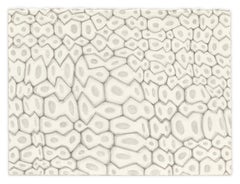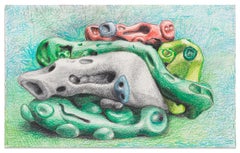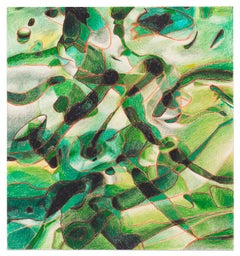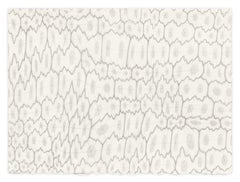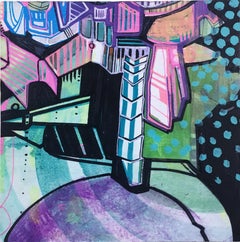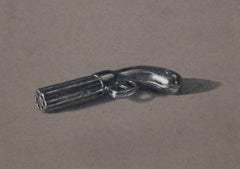Alexander Ross Drawings and Watercolor Paintings
4
1
Overall Width
to
Overall Height
to
5
1
3
2
1
1
1
1
1
4
4
2
1
1
12
932
406
282
279
1
4
5
Artist: Alexander Ross
Untitled
By Alexander Ross
Located in Saint Louis, MO
Alexander Ross
Untitled, 2007
Watercolor, colored pencil, gouache and graphite on paper
Framed Dimensions: 28 x 25.5 inches (71.1 x 64.8 cm)
Image Dimensions: 23 x 22 inches (58.4 ...
Category
Early 2000s Contemporary Alexander Ross Drawings and Watercolor Paintings
Materials
Watercolor, Gouache, Archival Paper, Color Pencil, Graphite
Price Upon Request
Fish
By Alexander Ross
Located in New York, NY
Alexander Ross
Fish, 2020
Graphite on paper
11 1/4 x 15 inches
28.6 x 38.1 cm
Signed, titled and dated (verso)
--
Best known for his mysterious biomorphic paintings...
Category
2010s Alexander Ross Drawings and Watercolor Paintings
Materials
Graphite
Price Upon Request
Color Clay Forms
By Alexander Ross
Located in New York, NY
Alexander Ross
Color Clay Forms, 2022
Color pencil, graphite
6 5/8 x 10 7/8 inches
16.8 x 27.6 cm
Signed, dated (verso)
--
Best known for his mysterious biomorphic paintings...
Category
2010s Alexander Ross Drawings and Watercolor Paintings
Materials
Oil
Price Upon Request
Untitled
By Alexander Ross
Located in New York, NY
Alexander Ross
Untitled, 2020
Color pencil, graphite
11 x 10 1/4 inches
27.9 x 26 cm
Signed and dated (verso)
--
Best known for his mysterious biomorphic paintings...
Category
2010s Alexander Ross Drawings and Watercolor Paintings
Materials
Graphite
Price Upon Request
Fuzzy Fish
By Alexander Ross
Located in New York, NY
Alexander Ross
Fuzzy Fish, 2020
Graphite on paper
11 1/4 x 15 inches
28.6 x 38.1 cm
Signed, titled and dated (verso)
--
Best known for his mysterious biomorphic paintings...
Category
2010s Alexander Ross Drawings and Watercolor Paintings
Materials
Graphite
Price Upon Request
Related Items
My 80's Heart "Token 5" 2019, gouache, acrylic, graphite, panel, purple, green
By Catherine Hart
Located in Jersey City, NJ
My 80's Hart "Token 5" 2019, gouache, acrylic, graphite, panel, purple, green, blue
Category
2010s Contemporary Alexander Ross Drawings and Watercolor Paintings
Materials
Acrylic, Gouache, Panel, Wood Panel, Graphite
Gun from Clue
By A.J. Fries
Located in Buffalo, NY
An original mixed media drawing by American artist A.J. Fries.
Category
21st Century and Contemporary Realist Alexander Ross Drawings and Watercolor Paintings
Materials
Gouache, Graphite, Paper
My 80's Heart "Token 7" 2019, gouache, acrylic, graphite, panel, blue, orange
By Catherine Hart
Located in Jersey City, NJ
My 80's Heart "Token 7" 2019, gouache, acrylic, graphite, panel, blue, wood, orange
Category
2010s Contemporary Alexander Ross Drawings and Watercolor Paintings
Materials
Acrylic, Gouache, Panel, Wood Panel, Illustration Board, Graphite
$120
H 5.5 in W 5 in D 1 in
Skull and Ornament - Vanitas, Still Life, Color Pencil Drawing, Framed
By John Hrehov
Located in Chicago, IL
Drawings of skulls are often called vanitas, which often contain collections of objects symbolic of the inevitability of death and the transience and vanity of earthly achievements and pleasures; it exhorts the viewer to consider mortality and to repent. This still life vanitas drawing is matted with a heavy white mat and framed in a bronze toned wooden frame measuring 15.75 x 16.25 inches.
John Hrehov
Skull and Ornament
colored pencil on paper
7h x 8w in
17.78h x 20.32w cm
JHR006
John Hrehov
Education
1985 MFA-Painting, University of Illinois at Urbana-Champaign
1981 BFA-Painting, Cleveland Institute of Art, Cleveland, OH.
Solo Exhibitions
2017 John Hrehov, Paintings and Drawings. Tom Thomas...
Category
2010s Surrealist Alexander Ross Drawings and Watercolor Paintings
Materials
Archival Paper, Color Pencil
French Expressionist Abstract Original Painting Artists Studio Provenance
Located in Cirencester, Gloucestershire
Abstract Expressionist Composition
by Jacques COULAIS (1955-2011)
gouache painting on paper/ card
unframed: 12.75 x 10 inches
condition: excellent
provenance: all the paintings we ha...
Category
Mid-20th Century Abstract Impressionist Alexander Ross Drawings and Watercolor Paintings
Materials
Oil
French Expressionist Abstract Original Painting Artists Studio Provenance
Located in Cirencester, Gloucestershire
Abstract Expressionist Composition
by Jacques COULAIS (1955-2011)
gouache painting on paper/ card
unframed: 11 x 7.5 inches
condition: excellent
provenance: all the paintings we have...
Category
Mid-20th Century Abstract Impressionist Alexander Ross Drawings and Watercolor Paintings
Materials
Oil
French Expressionist Abstract Original Painting Artists Studio Provenance
Located in Cirencester, Gloucestershire
Abstract Expressionist Composition
by Jacques COULAIS (1955-2011)
gouache painting on paper/ card
unframed: 12.75 x 9.75 inches
condition: excellent
provenance: all the paintings we ...
Category
Mid-20th Century Abstract Impressionist Alexander Ross Drawings and Watercolor Paintings
Materials
Oil
$135
H 12.75 in W 9.75 in D 1 in
French Expressionist Abstract Original Painting Artists Studio Provenance
Located in Cirencester, Gloucestershire
Abstract Expressionist Composition
by Jacques COULAIS (1955-2011)
gouache painting on paper/ card
unframed: 10 x 6.5 inches
condition: excellent
provenance: all the paintings we have...
Category
Mid-20th Century Abstract Impressionist Alexander Ross Drawings and Watercolor Paintings
Materials
Oil
"Some far away speech" Still life, Ink and watercolor
By Brian Spolans
Located in Philadelphia, PA
"Some far away speech" is an original ink and watercolor work on paper by Brian Spolans. The piece ships framed as pictured and measures 20.5in x 28.5in. Alternative custom framing...
Category
2010s Contemporary Alexander Ross Drawings and Watercolor Paintings
Materials
Ink, Watercolor, Archival Paper
French Expressionist Abstract Original Painting Artists Studio Provenance
Located in Cirencester, Gloucestershire
Abstract Expressionist Composition
by Jacques COULAIS (1955-2011)
gouache painting on paper/ card
unframed: 8.5 x 5.75inches
condition: excellent
provenance: all the paintings we hav...
Category
Mid-20th Century Abstract Impressionist Alexander Ross Drawings and Watercolor Paintings
Materials
Oil
My 80's Heart "Token 4" 2019, gouache, acrylic, graphite, panel, yellow, orange
By Catherine Hart
Located in Jersey City, NJ
My 80's Hart "Token 4" 2019, gouache, acrylic, graphite, panel, yellow, orange
Category
2010s Contemporary Alexander Ross Drawings and Watercolor Paintings
Materials
Acrylic, Gouache, Panel, Wood Panel, Graphite
$100
H 3.25 in W 5 in D 1 in
Diptych Edge of Whimsy
Located in Santa Cruz, CA
Acrylic paint with water-soluble Art Graf and graphite heightens the directness of marking in this diptych series on paper. Art Graf comes in tailor’s squares, easily fitting into th...
Category
2010s Abstract Alexander Ross Drawings and Watercolor Paintings
Materials
Graphite, Watercolor
Alexander Ross drawings and watercolor paintings for sale on 1stDibs.
Find a wide variety of authentic Alexander Ross drawings and watercolor paintings available for sale on 1stDibs. If you’re browsing the collection of drawings and watercolor paintings to introduce a pop of color in a neutral corner of your living room or bedroom, you can find work that includes elements of green and other colors. You can also browse by medium to find art by Alexander Ross in graphite, pencil, paint and more. Much of the original work by this artist or collective was created during the 21st century and contemporary and is mostly associated with the contemporary style. Not every interior allows for large Alexander Ross drawings and watercolor paintings, so small editions measuring 11 inches across are available. Customers who are interested in this artist might also find the work of Tom Shelton, Sarah Morejohn, and Patrick Willett. Alexander Ross drawings and watercolor paintings prices can differ depending upon medium, time period and other attributes. On 1stDibs, the price for these items starts at $3,500 and tops out at $4,500, while the average work can sell for $3,500.
